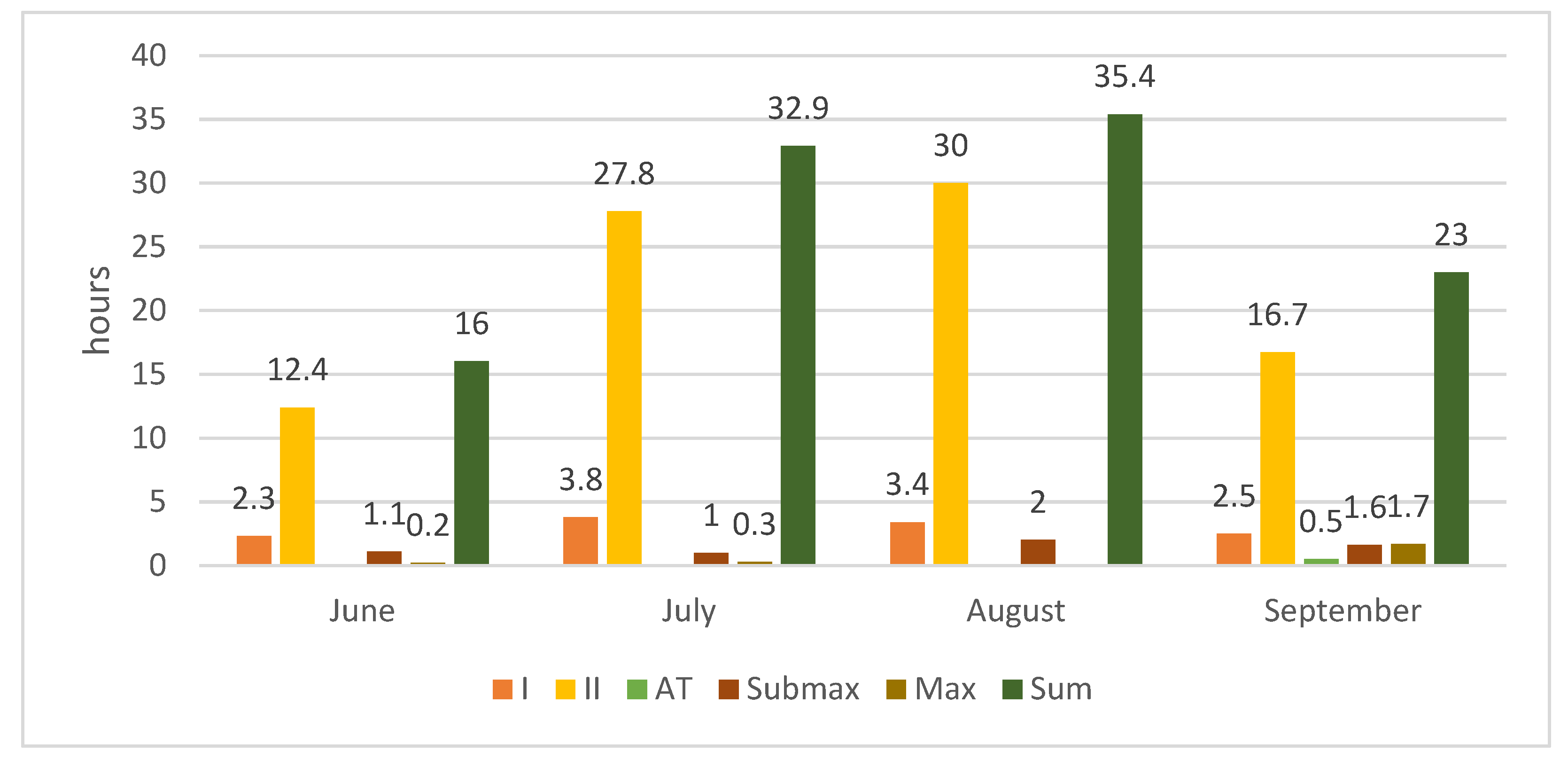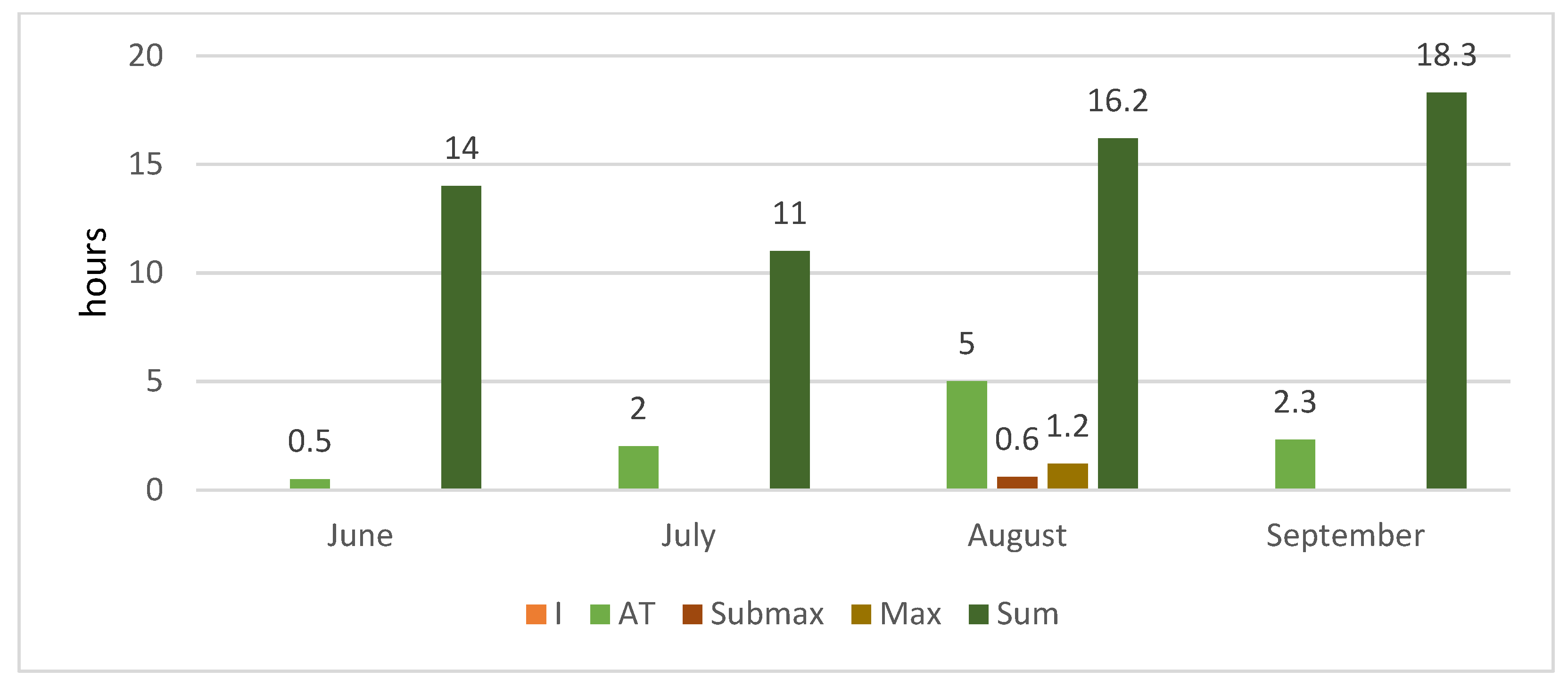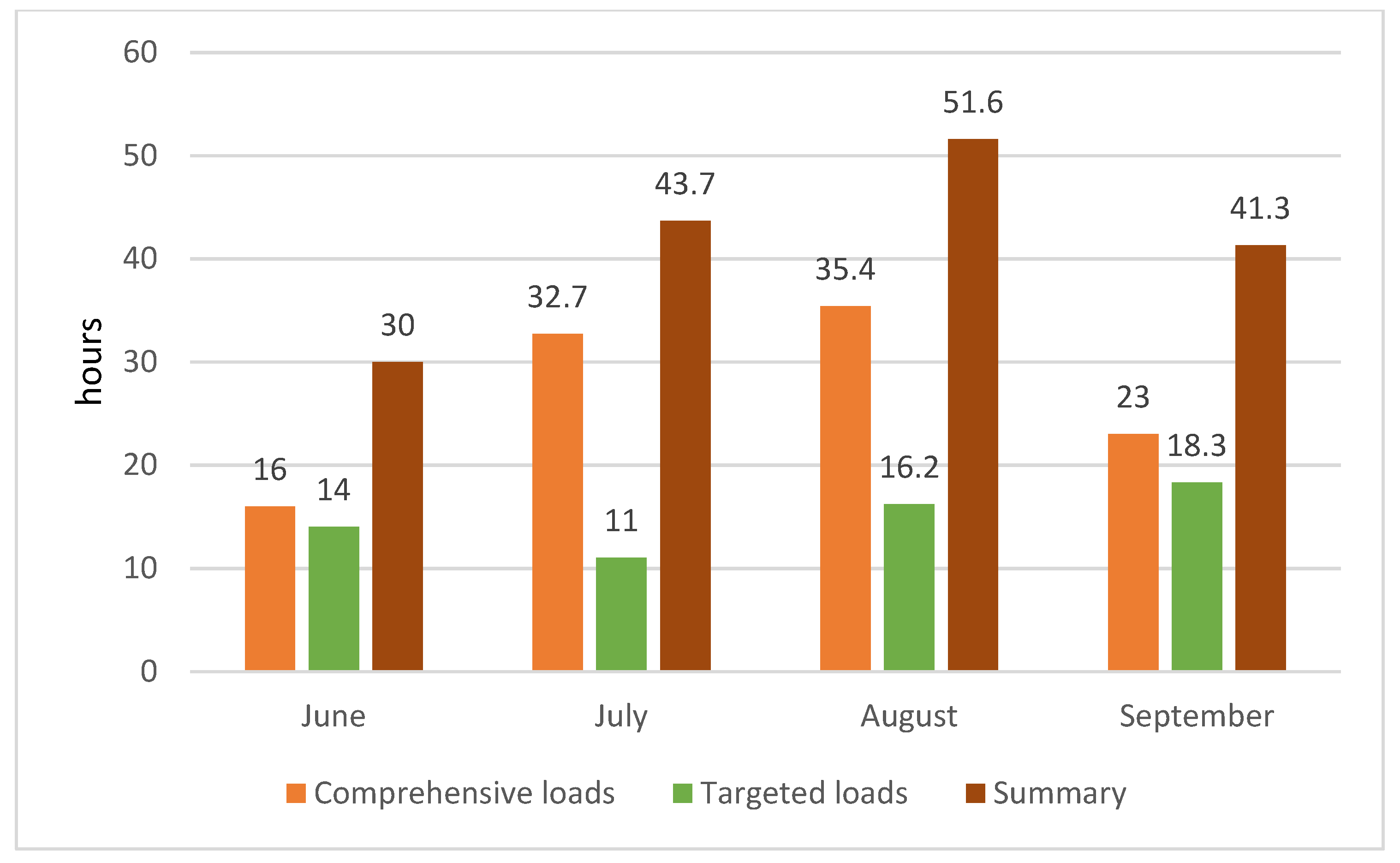The Influence of Endurance Training on the Lipid Profile, Body Mass Composition and Cardiovascular Efficiency in Middle-Aged Cross-Country Skiers
Abstract
:1. Introduction
2. Materials and Methods
2.1. Participants
2.2. Training Loads
2.3. Anthropometric and Aerobic Capacity Measurements
2.4. Blood Sampling and Analysis
2.5. Statistics
3. Results
Correlations for Independent Variables
4. Discussion
The Limitations of This Study
5. Conclusions
Author Contributions
Funding
Institutional Review Board Statement
Informed Consent Statement
Data Availability Statement
Conflicts of Interest
References
- Kokkinos, P. Physical Activity, Health Benefits, and Mortality Risk. Int. Sch. Res. Not. 2012, 2012, 718789. [Google Scholar] [CrossRef] [PubMed] [Green Version]
- Buttar, H.S.; Li, T.; Ravi, N. Prevention of cardiovascular diseases: Role of exercise, dietary interventions, obesity and smoking cessation. Exp. Clin. Cardiol. 2005, 10, 229–249. [Google Scholar] [PubMed]
- Pinckard, K.; Baskin, K.K.; Stanford, K.I. Effects of Exercise to Improve Cardiovascular Health. Front. Cardiovasc. Med. 2019, 6, 69. [Google Scholar] [CrossRef] [PubMed] [Green Version]
- Mann, S.; Beedie, C.; Jimenez, A. Differential Effects of Aerobic Exercise, Resistance Training and Combined Exercise Modalities on Cholesterol and the Lipid Profile: Review, Synthesis and Recommendations. Sports Med. 2013, 44, 211–221. [Google Scholar] [CrossRef] [Green Version]
- Wang, Y.; Xu, D. Effects of aerobic exercise on lipids and lipoproteins. Lipids Health Dis. 2017, 16, 1–8. [Google Scholar] [CrossRef] [Green Version]
- Lee, I.-M.; Sesso, H.D.; Oguma, Y.; Paffenbarger, J.R.S. Relative Intensity of Physical Activity and Risk of Coronary Heart Disease. Circulation 2003, 107, 1110–1116. [Google Scholar] [CrossRef] [Green Version]
- Physical Activity in the Prevention and Treatment of Disease; Professional Associations for Physical Activity: Stockholm, Sweden, 2010; ISBN 978-91-7257-715-2.
- Ren, J.; Zhang, Y.; Zhang, J.R.A.Y. Editorial: New Therapetic Approaches in the Management of Ischemia Reperfusion Injury and Cardiometabolic Diseases: Opportunities and Challenges. Curr. Drug Targets 2017, 18, 1687–1688. [Google Scholar] [CrossRef] [PubMed]
- Oja, P.; Laukkanen, R.M.T.; Kukkonen-Harjula, T.K.; Vuori, I.M.; Pasanen, M.E.; Solakivi, T. Training effects of cross-country skiing and running on maximal aerobic cycle performance and on blood lipids. Europ. J. Appl. Physiol. 1991, 62, 400–404. [Google Scholar] [CrossRef] [PubMed]
- WHO. Global Action Plan on Physical Activity 2018–2030: More Active People for a Healthier World; World Health Organization: Geneva, Switzerland, 2018; Licence: CC BY-NC-SA 3.0 IGO.
- Tanasescu, M.; Leitzmann, M.F.; Rimm, E.B.; Willett, W.C.; Stampfer, M.J.; Hu, F.B. Exercise Type and Intensity in Relation to Coronary Heart Disease in Men. JAMA 2002, 288, 1994–2000. [Google Scholar] [CrossRef]
- Eijsvogels, T.; Molossi, S.; Lee, D.-C.; Emery, M.; Thompson, P.D. Exercise at the Extremes: The amount of exercise to reduce cardiovascular events. J. Am. Coll. Cardiol. 2016, 67, 316–329. [Google Scholar] [CrossRef] [Green Version]
- Berry, C.; Balachandran, K.P.; L’Allier, P.L.; Lespérance, J.; Bonan, R.; Oldroyd, K.G. Importance of collateral circulation in coronary heart disease. Eur. Heart J. 2007, 28, 278–291. [Google Scholar] [CrossRef] [Green Version]
- Lara, B.; Salinero, J.J.; Gallo-Salazar, C.; Areces, F.; Ruiz-Vicente, D.; Martinez, M.; Del Coso, J. Elevation of Cardiac Troponins After Endurance Running Competitions. Circulation 2019, 139, 709–711. [Google Scholar] [CrossRef]
- Knechtle, B.; Nikolaidis, P.T. The Age of Peak Marathon Performance in Cross-Country Skiing—The “Engadin Ski Marathon”. J. Strength Cond. Res. 2018, 32, 1131–1136. [Google Scholar] [CrossRef] [PubMed] [Green Version]
- Luurila, O.J.; Karjalainen, J.; Viitasalo, M.; Toivonen, L. Arrhythmias and ST segment deviation during prolonged exhaustive exercise (ski marathon) in healthy middle-aged men. Eur. Heart J. 1994, 15, 507–513. [Google Scholar] [CrossRef] [PubMed]
- Burkule, N. Marathon running for amateurs: Benefits and risks. J. Clin. Prev. Cardiol. 2016, 5, 113. [Google Scholar] [CrossRef]
- Losnegard, T.; Hallén, J. Physiological Differences Between Sprint- and Distance-Specialized Cross-Country Skiers. Int. J. Sports Physiol. Perform. 2014, 9, 25–31. [Google Scholar] [CrossRef] [Green Version]
- Izzo, R.; Giovannelli, M. Edwards TL Method and D_SHI(m): Intensity descriptors. Sport Sci. 2017, 10, 104–110. [Google Scholar]
- Losnegard, T. Energy system contribution during competitive cross-country skiing. Eur. J. Appl. Physiol. 2019, 119, 1675–1690. [Google Scholar] [CrossRef] [Green Version]
- Green, S.; Dawson, B. Measurement of anaerobic capacities in Humans. Sports Med. 1993, 15, 312–327. [Google Scholar] [CrossRef]
- Johnson, R.; McNutt, P.; MacMahon, S.; Robson, R. Use of the Friedewald Formula to Estimate LDL-Cholesterol in Patients with Chronic Renal Failure on Dialysis. Clin. Chem. 1997, 43, 2183–2184. [Google Scholar] [CrossRef] [Green Version]
- Nystoriak, M.A.; Bhatnagar, A. Cardiovascular Effects and Benefits of Exercise. Front. Cardiovasc. Med. 2018, 5, 135. [Google Scholar] [CrossRef] [Green Version]
- Knechtle, B.; Nikolaidis, P.T. Physiology and Pathophysiology in Ultra-Marathon Running. Front. Physiol. 2018, 9, 634. [Google Scholar] [CrossRef] [Green Version]
- Rusko, H. The effect of training on aerobic power characteristics of young cross-country skiers. J. Sports Sci. 1987, 5, 273–286. [Google Scholar] [CrossRef]
- Lalonde, F.; Martin, S.M.; Boucher, V.G.; Gosselin, M.; Roch, M.; Comtois, A.S. Preparation for an Half-Ironmantm Triathlon amongst Amateur Athletes: Finishing Rate and Physiological Adaptation. Int. J. Exerc. Sci. 2020, 13, 766–777. [Google Scholar] [PubMed]
- Puccinelli, P.J.; Lima, G.H.; Pesquero, J.B.; de Lira, C.A.; Vancini, R.L.; Nikolaids, P.T.; Knechtle, B.; Andrade, M.S. Previous experience, aerobic capacity and body composition are the best predictors for Olympic distance triathlon performance: Predictors in amateur triathlon. Physiol. Behav. 2020, 225, 113110. [Google Scholar] [CrossRef] [PubMed]
- Barbieri, D.; Zaccagni, L.; Babic, V.; Rakovac, M.; Misigoj-Durakovic, M.; Gualdi-Russo, E. Body composition and size in sprint athletes. J. Sports Med. Phys. Fit. 2017, 57, 1142–1146. [Google Scholar]
- Bassett, D.R.; Howley, E.T. Limiting factors for maximum oxygen uptake and determinants of endurance performance. Med. Sci. Sports Exerc. 2000, 32, 70–84. [Google Scholar] [CrossRef] [PubMed]
- Arriel, R.A.; Graudo, J.A.; Duarte de Oliveira, J.L.; Ribeiro, G.G.S.; Meireles, A.; Marocolo, M. The relative peak power output of amateur mountain bikers is inversely correlated with body fat but not with fat-free mass. Mot Rev. Educ. Física 2020, 26. [Google Scholar] [CrossRef]
- Lyudinina, A.Y.; Ivankova, G.E.; Bojko, E.R. Priority use of medium-chain fatty acids during high-intensity exercise in cross-country skiers. J. Int. Soc. Sports Nutr. 2018, 15, 1–8. [Google Scholar] [CrossRef] [PubMed] [Green Version]
- Wu, N.N.; Tian, H.; Chen, P.; Wang, D.; Ren, J.; Zhang, Y. Physical Exercise and Selective Autophagy: Benefit and Risk on Cardiovascular Health. Cells 2019, 8, 1436. [Google Scholar] [CrossRef] [PubMed] [Green Version]
- Purdom, T.; Kravitz, L.; Dokladny, K.; Mermier, C. Understanding the factors that effect maximal fat oxidation. J. Int. Soc. Sports Nutr. 2018, 15, 1–10. [Google Scholar] [CrossRef] [Green Version]
- Achten, J.; Jeukendrup, A.E. Optimizing fat oxidation through exercise and diet. Nutrition 2004, 20, 716–727. [Google Scholar] [CrossRef]
- Gaskill, S.E.; Serfass, R.C.; Bacharch, D.W.; Kelly, J.M. Responses to training in cross-country skiers. Med. Sci. Sports Exerc. 1999, 31, 1211–1217. [Google Scholar] [CrossRef]
- Fisher, G.; Brown, A.W.; Brown, M.M.B.; Alcorn, A.; Noles, C.; Winwood, L.; Resuehr, H.; George, B.; Jeansonne, M.M.; Allison, D.B. High Intensity Interval- vs Moderate Intensity- Training for Improving Cardiometabolic Health in Overweight or Obese Males: A Randomized Controlled Trial. PLoS ONE 2015, 10, e0138853. [Google Scholar] [CrossRef]
- Lee, D.-C.; Sui, X.; Artero, E.G.; Lee, I.-M.; Church, T.S.; McAuley, P.A.; Stanford, F.C.; Kohl, H.W., 3rd; Blair, S.N. Long-Term Effects of Changes in Cardiorespiratory Fitness and Body Mass Index on All-Cause and Cardiovascular Disease Mortality in Men: The Aerobics Center Longitudinal Study. Circulation 2011, 124, 2483–2490. [Google Scholar] [CrossRef] [Green Version]
- Kaminsky, L.A.; Arena, R.; Beckie, T.M.; Brubaker, P.H.; Church, T.S.; Forman, D.E.; Franklin, B.A.; Gulati, M.; Lavie, C.J.; Myers, J.; et al. The importance of cardiorespiratory fitness in the United States: The need for a national registry: A policy statement from the American Heart Association. Circulation 2013, 127, 652–662. [Google Scholar] [CrossRef] [Green Version]
- Trejo-Gutierrez, J.F.; Fletcher, G. Impact of exercise on blood lipids and lipoproteins. J. Clin. Lipidol. 2007, 1, 175–181. [Google Scholar] [CrossRef] [PubMed]
- Stray-Gundersen, J.; Denke, M.A.; Grundy, S.M. Influence of lifetime cross-country skiing on plasma lipids and lipoproteins. Med. Sci. Sports Exerc. 1991, 23, 695–702. [Google Scholar] [CrossRef]
- Shaw, I.; Shaw, B.S.; Krasilshchikov, O. Comparison of aerobic and combined aerobic and resistance training on low-density lipoprotein cholesterol concentrations in men. Cardiovasc. J. Afr. 2009, 20, 290–295. [Google Scholar] [PubMed]
- Aadahl, M.; Kjær, M.; Jørgensen, T. Associations between overall physical activity level and cardiovascular risk factors in an adult population. Eur. J. Epidemiol. 2007, 22, 369–378. [Google Scholar] [CrossRef] [PubMed]



| Parameter Median (Interquartile Range, IQR) | Result 1 | Result 2 | p-Value |
|---|---|---|---|
| Body weight (kg) | 79.5 (7.3) | 78.2 (5.9) | 0.333 |
| BMI (kg/m2) | 23.9 (1.0) | 23.9 (0.9) | 0.191 |
| % body fat mass | 15.5 (3.5) | 14.4 (3.4) | 0.038 |
| Body fat mass (kg) | 11.1 (4.0) | 10.1 (3.4) | 0.023 |
| Relative VO2max (mL/kg/min) | 49.6 (5.0)) | 51.6 (4.3) | 0.008 |
| Maximum heart rate (bpm) | 187.0 (7.5) | 183.0 (10.0) | 0.195 |
| Cholesterol high-density lipoproteins (HDL) (mg/dL) | 58.1 (13.2) | 55.7 (25.5) | 0.551 |
| Cholesterol non-HDL (mg/dL) | 114.2 (39.4) | 112.7 (37.7) | 1.000 |
| Cholesterol low-density lipoproteins (LDL) (mg/dL) | 98.7 (35.4) | 98.8 (39.1) | 0.233 |
| Triglycerides (mg/dL) | 72.0 (40.2) | 56.0 (54.4) | 0.572 |
| Total cholesterol (mg/dL) | 165.0 (38.2) | 169.0 (39.1) | 0.286 |
| Variable | p-Value | Correlation (R Spearman) |
|---|---|---|
| Body weight (kg) | 0.049 | −0.5278 |
| BMI (kg/m2) | 0.069 | −0.4782 |
| % body fat mass | 0.880 | 0.0778 |
| Body fat mass (kg) | 0.858 | −0.0612 |
| Maximum heart rate (bpm) | 0.138 | 0.4464 |
| Cholesterol high-density lipoproteins (HDL) (mg/dL) | 0.538 | 0.1838 |
| Cholesterol non-HDL (mg/dL) | 0.712 | −0.1077 |
| Cholesterol low-density lipoproteins (LDL) (mg/dL) | 0.699 | −0.1207 |
| Triglycerides (mg/dL) | 0.956 | 0.0201 |
| Total cholesterol (mg/dL) | 0.247 | −0.3328 |
Publisher’s Note: MDPI stays neutral with regard to jurisdictional claims in published maps and institutional affiliations. |
© 2021 by the authors. Licensee MDPI, Basel, Switzerland. This article is an open access article distributed under the terms and conditions of the Creative Commons Attribution (CC BY) license (https://creativecommons.org/licenses/by/4.0/).
Share and Cite
Grzebisz-Zatońska, N.; Grzywacz, T.; Waśkiewicz, Z. The Influence of Endurance Training on the Lipid Profile, Body Mass Composition and Cardiovascular Efficiency in Middle-Aged Cross-Country Skiers. Int. J. Environ. Res. Public Health 2021, 18, 10928. https://doi.org/10.3390/ijerph182010928
Grzebisz-Zatońska N, Grzywacz T, Waśkiewicz Z. The Influence of Endurance Training on the Lipid Profile, Body Mass Composition and Cardiovascular Efficiency in Middle-Aged Cross-Country Skiers. International Journal of Environmental Research and Public Health. 2021; 18(20):10928. https://doi.org/10.3390/ijerph182010928
Chicago/Turabian StyleGrzebisz-Zatońska, Natalia, Tomasz Grzywacz, and Zbigniew Waśkiewicz. 2021. "The Influence of Endurance Training on the Lipid Profile, Body Mass Composition and Cardiovascular Efficiency in Middle-Aged Cross-Country Skiers" International Journal of Environmental Research and Public Health 18, no. 20: 10928. https://doi.org/10.3390/ijerph182010928
APA StyleGrzebisz-Zatońska, N., Grzywacz, T., & Waśkiewicz, Z. (2021). The Influence of Endurance Training on the Lipid Profile, Body Mass Composition and Cardiovascular Efficiency in Middle-Aged Cross-Country Skiers. International Journal of Environmental Research and Public Health, 18(20), 10928. https://doi.org/10.3390/ijerph182010928








